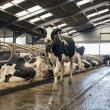Adopting a routine for weighing youngstock
The old adage, ‘If you can’t measure it, you can’t manage it’ is highly appropriate when it comes to weighing routines for youngstock. Liz Newman of Advanced Ruminant Nutrition offers some pointers. Wendy Short reports for Dairy Farmer Magazine

A comparison of cattle feed conversion efficiency illustrates the critical importance of monitoring youngstock performance, says Liz.
“Extensive research has shown that the most cost-effective period for weight gain is from weaning to six months,” she explains. “A heifer calf on milk will convert feed at a ratio of about 2:1, with conversion efficiency declining with age, so it is essential to maximise growth during the early rearing period. A heifer should reach 55-60 per cent of her predicted adult weight at bulling, and 85-95 per cent by the time she calves down. Hitting these targets will require regular weight monitoring.
“Five weigh sessions in the first six months is the ideal for adult weight prediction and service date identification. Nevertheless it is better to take fewer, but accurate, weights, rather than using frequent ‘guesstimates.’ Some producers can run calves through a weighbridge direct from the pen, while others have to move them some distance away and obviously that can be time-consuming.”
Where possible, calves should be weighed individually, she says.
“However, sample weighing is certainly preferable compared with no weighing. Try and get a true sample, possibly selecting all the calves with either odd or even tag numbers, for example. Another option is to weigh the first batch of calves that are caught. Avoid sampling twins, because that can skew the data. The same calves should be weighed every time when using a sample system, and weights should be taken from a minimum of 10 individuals in a pen of 20 animals.
“The weighing routine may highlight calves which are significantly above or below target. This allows action to be taken at an early stage and will help to improve group uniformity. It can provide an alert that something is going wrong and that should prompt a management review. In some cases, weaning may have been too abrupt, or the pen groups are too large. Another common cause of growth checks is dehorning too close to weaning time. The majority of issues are linked to stress and the causes are usually farm-specific.”
Electronic weigh scales used in combination with a calf crush are a worthwhile investment, given the vital role that heifer weights play in future performance, she stresses.
“I have found it difficult to achieve accuracy using a height stick, particularly because most cattle will not stand still for long enough to take a proper reading. A weigh tape can be a viable alternative to electronic weighing, but it should be done by the same person every time because there will be slight differences in technique.
“I have experimented by using electronic scales followed by a weigh tape and there is around 2kgs difference either way in the result. The calf would need to stand in a ‘show’ pose, with a leg in each corner and her head up, to use a weigh tape correctly. In reality, most will have their heads down after being restrained; that can change the reading by several kilos.”
Liz advises producers to compare their cattle weight gain figures against other farms.
“Most farms have some system of weighing heifers and a number of feed firms and vets offer the opportunity to join a benchmarking scheme. This is very useful for identifying practices that have the potential to improve performance.”
She urges producers to maintain a weighing routine.
“Some units stop weighing heifers after the six-month stage, but I would encourage its continuation. Studies indicate that calving at 22-24 months is the most profitable option. A period of rapid growth is required in the run-up to service to reach this goal.
“Heifers will need to have had a first oestrus by 13 months and it may take multiple services before they hold. If the average cow weight is 660kgs, a heifer should weigh 380kgs at service if she is to calve successfully.
“Judging service readiness by eye can be extremely misleading; heifers can reach the appropriate weight at anywhere between 11-16 months, but they may not have developed the right frame. Therefore accurate weighing is the best way of making correct decisions about service dates,” she says.
Feeding for Maximum Weight Gain
An 18 per cent protein concentrate fed with straw is not sufficient to reach weight gain and frame goals for young calves, says Liz.
“I recommend a 20 per cent nut, plus access to high quality straw. A total mixed ration containing silage can be introduced post-six months, and the protein content of the concentrates can then be reduced to match the silage. Every farm is different but in general, the overall dietary protein should be 15-16%, while ME should not generally rise above 10.5.
“Growing heifers are prone to laying down fat at the expense of frame,” she says. “Encouraging skeletal and lean muscle development with a diet high in good quality protein is essential for minimising fat. Regular body condition scoring, alongside weighing, will ensure that heifers calve down at the correct weights.
“The same ration fed on two separate farms can produce very different results, with one group performing well and the other laying down fat. Formulations may look good on paper, but they will often need to be tweaked to individual farm requirements,” says Liz.
〈 BACK














